The LED, acronym of Light Emitting Diode, represents the evolution of lighting and one of the most appreciated innovative technologies by professionals in the lighting sector for its versatility and flexibility. We are talking about an electronic component in which the generation of light takes place by means of semiconductors when it is powered.
In this article, we will discuss the advantages of using this technology in lighting design.
More specifically we will be talking about:
Do you want to keep up to date on the latest company news and trends in the lighting, HVAC, HoReCa and Household Appliance sectors? Click on the button below and subscribe to the SLIM newsletter!

LED technology: the advantages for the lighting sector
LED technology is currently one of the light sources that best meets the needs of lighting engineers, designers and planners. Its popularity lies in the numerous advantages that stem from the intrinsic characteristics of the LED. Let's look at them together.
The LED is a safe and non-polluting solution: it does not contain gases or toxic substances that are harmful to health.
With a good heat dissipation system, especially for high-brightness LED lamps, this type of source guarantees greater luminous efficiency and life compared to other solutions.
LEDs have the advantage of a long life compared to other lamps: the life of an LED starts at 20,000 hours and can last up to 100,000 hours. The actual lifetime, however, cannot disregard variables such as the application, the working temperature and how the LED is stressed. This is a significant margin of use, bearing in mind that incandescent lamps have an estimated life of 750 hours and fluorescent lamps 7500 hours.
This component is also known for its considerable energy savings: it is energy efficient, producing 90 to 100 lumens per watt. With the same power input as other types of lamp, the LED has up to five times the luminous flux. The power used is therefore put to better use for lighting, optimising efficiency.
Finally, LED lamps boast greater robustness. The material used to make the diodes is more resistant to shocks or other stresses, making the LED ideal for designing special lighting solutions.
Lighting Design with LEDs
As mentioned above, the technical characteristics and advantages of using LEDs make them suitable for both domestic and industrial lighting applications.
From the application point of view, their use for lighting solutions is also due to the flexibility of design and installation of the lighting point. The LED is a small and discreet light source, easily adaptable to the small footprint required for some specific applications.
The number of LEDs to be used depends on the type of application and product in which the light fitting is to be inserted, the insertion position, the light distribution (homogeneous or with light spots) and the required power. A single LED may be sufficient, or there may be a need for several LEDs placed on customised PCBs or COBs (Chip on Board) of different shapes and sizes, created ad hoc based on the requirements presented.
Another very important parameter in LED lighting design is colour rendering. A higher colour rendering index serves to make colours stand out as naturally as possible. With LEDs, it is also much easier to create dynamic colour effects with RGB. It should be noted that LEDs generate a narrow-band spectrum. The generated, dominant wavelength is what determines the colour point of the LED. Unlike coloured fluorescent lamps, LEDs have a higher colour saturation.
SLIM's technical department is structured to support designers in defining the concept of the appropriate lighting solution for their final application. The customer is supported in all the steps of the project definition. The design of a customised lighting fixture is carried out in compliance with the regulations and the functional and aesthetic requirements of the customer.
Are you interested in a lighting solution for a lighting project? We will be happy to help you choose the most suitable luminaire for your needs. Click on the button below for more information!

